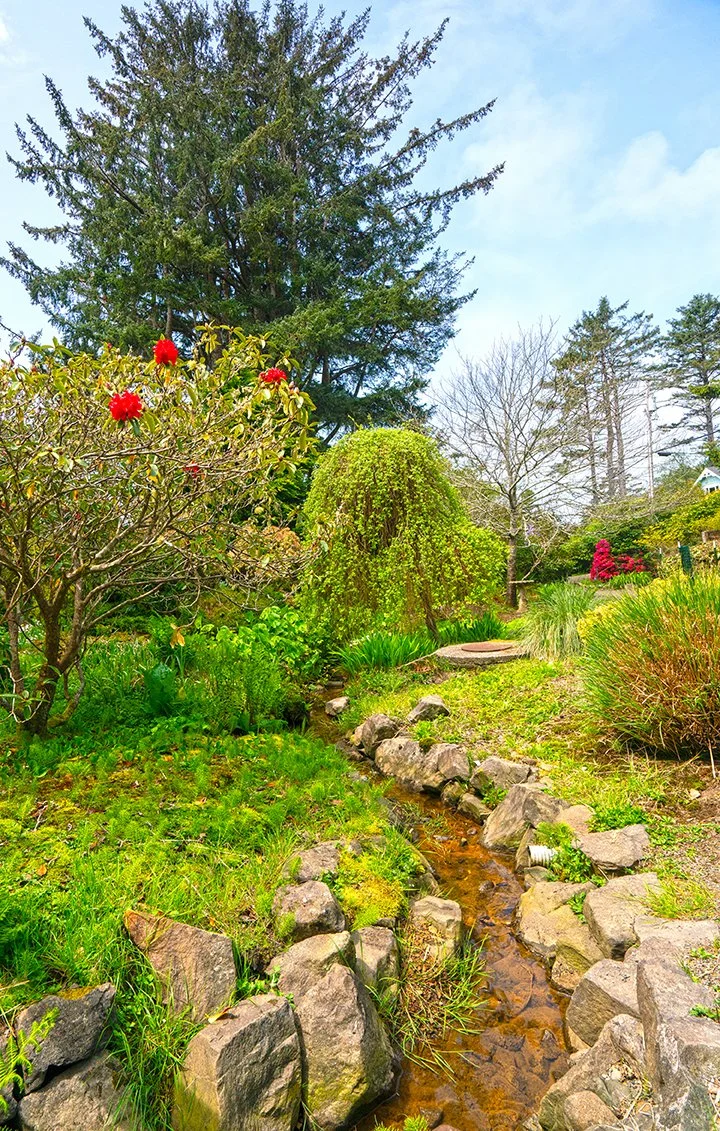Plotting a new root
The Connie Hansen Garden enters a new era in Lincoln City



Story & Photos by Eliot Sekuler
For the TODAY
The landscape has been evolving and changing since the first flowers and shrubs were planted more than 50 years ago. And this year will bring another dramatic transformation to Lincoln City’s Connie Hansen Garden.
Located just 100 yards off Highway 101, the privately-maintained public garden is a compact site, encompassing slightly more than a single acre, but its pathways and gardens are craftily laid out to create the sense of a much larger space. A narrow brook runs through the property and the paths are connected by short wooden bridges that enhance the postcard-like ambiance of the grounds. It’s easy for a visitor to get lost there, confused by the crisscross of pathways and disoriented by the stunning display of flowers and shrubs and trees that form its jewel-like landscape.
On a recent mid-April day, the first pale green leaves of the season were appearing on black alders and northern red oaks and the buds of some rhododendrons were beginning to flash blood red petals. Just two weeks later, in early May, the landscape had changed with the onset of this year’s delayed spring. Stalks of columbine were in full bloom along with expanses of the pale bluebell campanulas. A carpet of yellow meadowfoam flowers glinted in the sun and the garden’s collection of some 300 rhododendrons were exploding with color.
Sadly, many of those rhododendrons will soon be gone. Some of them, along with some other shrubs, have been infected with phytophthora ramorum, the pathogen associated with “sudden oak death” disease. By fall of this year, about 100 infected rhododendrons along with some of the garden’s azaleas, huckleberries and ferns must be removed.
“An awful lot of the mature rhododendrons are coming out, so the environment will be changing rapidly,” said Priscilla Patterson, who has served as head gardener at the Connie Hansen Garden for the past 15 years. Patterson will be working with her team of about a half dozen volunteer gardeners to find replacement plants as the infected trees and shrubs are taken out and the ground is treated to eliminate the pathogen.
“We’ll be replacing them with plants that are not on a list of susceptible species,” she said, “which eliminates an awful lot of things that we’d otherwise be planting, plants that we know do really well here.”
In some ways, the new look of the garden will more closely resemble what Connie Hansen originally created when she first landscaped the site.
“Connie Hansen bought the garden in 1973 and she passed away in 1993,” Patterson said. “She gardened it for 20 years and she kept planting the entire time. There was pretty much nothing here when she started creating her beds. It was very open: there weren’t a lot of trees and there wasn’t a lot of shade, so she planted things that were sun-loving. But she loved flowering trees and especially rhododendrons. Over the years, they’ve all grown up and it’s become increasingly shady and the garden has become more of a shade garden than a sun garden. But now, that’s going to be changing.” In some ways, the changes that are being imposed upon the garden will bring it back to a more original form.
Although Patterson can’t yet determine what will replace the plants that must be eliminated, she promises a landscape that will be worthy of the garden’s venerable tradition.
“We have ideas about what we’d like to see, but it will depend on cost and availability,” she said. “It’s going to be different but we just don’t know what we’ll be able to plant just yet. It’s hard to design a planting before you see the land you have to work with; and we won’t see that until all the infected plants are gone, probably by mid-summer. We do know that it’s going to be sunnier with so many of our rhododendrons gone, a lot more open, so we’ll be planting a lot more flowers. It will be different, but people will see plenty of blooms and it will be beautiful.”
The process of preserving and re-planting the garden will strain the resources of the Connie Hansen Conservatory, which operates as a non-profit 501c3 tax-exempt organization.
“We need donations and we need volunteers,” Patterson said. “We need those things more than ever. Any support we can get from the public would be a tremendous help.”
The Connie Hansen Garden is open every day from dawn to dusk. Admission is free, but donations are welcome. For more information, go to conniehansengarden.com or call 541-994-6338.

